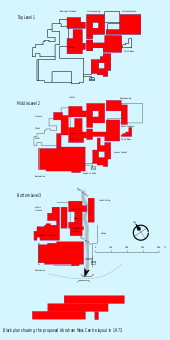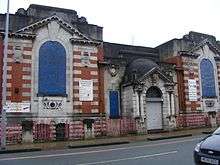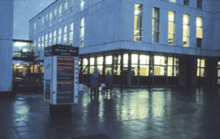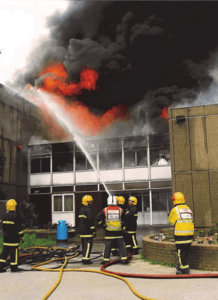Abraham Moss Community School
| Established | 1973 |
|---|---|
| Headteacher | Miss G Houghton |
| Location |
Crescent Road Manchester Greater Manchester M8 5UF England Coordinates: 53°30′42″N 2°14′09″W / 53.51179°N 2.23579°W |
| Local authority | Manchester |
| DfE URN | 105560 Tables |
| Ofsted | Reports |
| Students | 1200 |
| Gender | Mixed |
| Ages | 5–16 |
Abraham Moss Community School is a mixed all-through school located on a 19 hectare site situated on Crescent Road in the Crumpsall/Cheetham Hill district of North Manchester, Greater Manchester, England, next to the Abraham Moss Metrolink station. The complex also includes a leisure centre, the district library and a 230-person theatre complex. The centre also hosts other tenants mainly in the public, voluntary and community sectors.[1] It is named after Abraham Moss, Lord Mayor of Manchester (1953–54).
History
The Abraham Moss opened in 1973 as a multipurpose integrated centre with lower school, and upper school seamlessly joining to a FE college, a library and a leisure centre. The first principal was Ron Mitson, with Dave Shapcott being head of school. It aimed to teach through independent resource-based learning[2]- staff developed and pasted up their own materials which were then taken to the printroom, where the masters were allocated an accession number and the printroom staff would print the required number of copies on offset litho machines. It was referred to as a school without books. The building was featured in a DES best practice building report.[3]
It was one of six such centres[4] built around that time that were characterised by shared-use area, collaboration across phases with an inclusive approach to the pupils, their welfare and developing their potential. They all had innovative curriulums and purpose designed buildings.[5] It was built at a cost of ₤2.472 m.[3]
Manchester City Libraries moved the stock from Crumpsall Library in 1974. The stock transfer, and subsequent change in the reader profile was subject to a study in 1979 published in the Journal of Librarianship and Information Science.[6] In effect, the number of younger readers increased by 88% but the over 65s stopped coming.
In 2012 to answer the shortage of primary places in North Manchester, the Moss became an all-through 5-16 school, with a two form primary intake. The first reception class children arrived in September 2012.[5]
The head teacher David Watchorn has taught at the school since it opened in 1973, and became head in 1984. The 2003 Ofsted report reports
He has been a force for stability and continuity throughout the school's history, not least when the school "kept going" in the immediate aftermath of the devastating fire of 1997; but he has also grasped the need for change and development and in recent years has helped to fix the staff's attention on the need to raise standards of attainment.
However, despite Watchorn's distinguished and distinctive service to the school and the young people of the area, he was suspended in July 2013 because he publicly disagreed with the City Council about some aspects of the primary school development. It should be noted that Manchester City Council's relationship with its heads has often been stormy and it has a history of suspending headteachers,[8]
Gillian Houghton, a former vice-principal at Co-operative Academy in Higher Blackley (Plant Hill) has been appointed principal.
Site

The building is on three levels, on falling land, bridging a pedestrian spine, 'the right of way', between Crescent Road and Woodlands Road which is reached through an underpass beneath the Bury line railway. The 9.5 ha of the 13 ha site had been a chemical waste tip, and the remaining 3.5 ha were formerly municipal allotments, to the south of the site the land falls away towards the Irk valley at the time it was informal open space.[9] The southern boundary is defined by the former industrial branch line than led to Crumpsall Vale. The buildings were placed on the former allotment land. This has a high water table, and a subsoil of lenticulated glacial drift containing pockets of clay and running sand overlain in part by peat, so this is not very stable. Before landscaping the waste tip was covered with a 6m layer of clean top soil. [10]
Community education
Community education, as practised by Cambridgeshire village colleges of the 1930s,[11] was seen as a viable solution for the densely populated long-established communities in areas in need of urban regeneration. Manchester City Council recognised that factors in Cheetham Crumpsall made this area where the experiment could take place. Community Education envisages that the school is the centre of the community, and instead of being closed to all but its pupils, the community should be encouraged. This is done by integrating sports and cultural facilities. Shared use creates financial saving- and the shared identity binds and strengthens the community which eventually takes over the running and management of the facility.
In the case of the Moss, Cheetham Secondary Modern School was due to be rebuilt; following DES Circular 10/65 selection was to be abolished and schools reorganised on comprehensive lines. Rebuilding was included in the 1967–68 and 1968–69 major building programme. Provision for an 800 fte student further education college to be located on Cheetham Hill Road had been approved in 1967, land at Crescent Road would be cheaper and offered further savings if the two were to be in one building. The adult education centre was to move from old buildings adjacent to Cheetham Secondary Modern School to the proposed FE college. It would move too.[12]

Need had been identified in the area for a youth club, a residential unit for short stay accommodation for children and an elderley and handicapped persons' club with facilities for centralised catering. Providing these in one building was seen as attractive and cost effective.
The existing 19th century public baths on Cheetham Hill Road were due to be closed and replaced with a district sports and recreation centre that would have playing fields, outdoor public recreation space, sports halls and swimming pools. It too was at the early planning stage. Similarly, the Edwardian public library was no longer adequate. On a combined site it could provide the reference materials needed for college and school, and have a full lending library with children section and study space. It would have 60,000 volumes.[13]
Thus, the finance and will to integrate was present, and Manchester was prepared to take the risk.[14]
The 1973 buildings
The 1973 building was constructed using the CLASP Mk 4b system. .[15] CLASP was a building construction technique introduced post-war and popular in the 1960s for short-term, cheap and easily constructed buildings such as schools,[16]fire stations, libraries etc.

CLASP buildings of wood and concrete panel construction encompass a vast number of hidden voids for services. CLASP Mk 4b was the incarnation used between 1969 and 1972, measurements were imperial using 4" as the basic unit. Panels were multiples of this - that is 12 inches or 1 foot, 3 foot, 6 foot and 9 foot. The planning grid was 12x12 inches, and a structural grid of 36x36 inches. The preferred floor to ceiling heights were 8 ft and 10 ft. The structure was steel frame with a 6 ft bay.[17] It was hung with external 10 ft by 3 ft pre-fabricated concrete panels. The interior partitions were built using plastic-faced, plasterboard-backed steel Stelvelite panels. There was a hung exposed-T ceiling with 36x36 inch mineral tiles. The void above was used for service ducting, heating, electric power and lighting. The system was not heavy which was important due to the difficult sub-soil, and quick to erect which was important due to the tight time scale.[18] It was designed to have a 60-year life. Hindsight shows that the extensive voids were a design fault, and many CLASP buildings have been destroyed by fire and have posed an asbestos risk.
The Moss was designed between 1968 and 1970 by the DES Development Group, the principal architects being David and Mary Medd, Michael Hacker and Ian Fraser.[19] A significant choice as David and Mary Medd have been leading school architects for 40 years. The curriculum was intended to align to the design of the centre. This was envisages as a network of multidisciplinary centres, an idea, that through their work at Maiden Erlegh, springs from a recommendation in the Newsom Report pages 46–48. The 24,000 m² complex was a low and compact 3 storey CLASP network, lit by small courtyards with 25 dispersed entrances linked by high level footbridges with an 'internal street'. Each component still had to satisfy multiple design regulations. The lower school was designed to provide a sheltered and identifiable environment for younger pupils (year 7-year 8). There were four centres or bases for smaller groups of 120 pupils and their five principal teachers who worked in a team to deliver resource based multidisciplinary project based work. The bays were 90% self-sufficient, and the lower school had its own hall and dining area with pullman style bays to further satisfy design requirements and shelter the pupils.[19]
Arson

Two of the three school block were gutted in an arson attack on Friday, 15 May 1997. This destroyed the buildings, the collected resources and all school records. In spite of this the school reopened in makeshift accommodation in other parts of the centre, the Monday after the weekend.[20] It was thought a group of teenagers, drunk or on drugs were responsible: No-one was charged for the attack.[21] [22] The BBC reported that the blaze, caused five million pounds worth of damage, destroying two-thirds of the school buildings, forty eight classrooms including the drama and music suites.
There was no sprinkler system, and some of the fire barriers in the ceilings had been pierced during alterations to the building. The blaze, one of the biggest seen in Manchester since the Second World War was brought under control by 160 firemen using 30 appliances.[20]
Richard Jobson, Chief Education Officer for Manchester said:
It's a bit like an act of terrorism. There was twenty four hours security here and I haven't heard one single word of criticism from people saying that you didn't do enough. In fact on the contrary we're now fairly well experienced. I mean small fires and vandalism is part of our working life, so we've got used to the notion of making our buildings as secure as possible.[22]
A temporary school of 40 classrooms was constructed out of portacabins on the tennis courts to service the nine hundred staff and pupils.[20]
2012 expansion
There was a large rise in the birth rate in 2008 in Manchester, manifesting in the need for many extra primary school places starting in 2012. Government legislation prevents Manchester City Council from fulfilling it statutory duty by building new schools to accommodate these children, they can only expand existing schools. Twenty seven primary schools were asked to increase their admission numbers by at least 15, and Abraham Moss was asked to change its designation from an 11-16 school to a 5-16 all-through school.[23] The response was favourable, but there are tensions on how some of the existing facilities should be managed, issues such as outdoor play, indoor play and use of the theatre being at dispute. It is hoped to move the library from within the main-centre to a site within the leisure centre allowing the remaining CLASP 4b cladding to be replaced. It will have a separate entrance. The library and the primary school both wish to claim some key areas.[23]
Current facilities
It comprises a school, an adult learning centre (City College), a library, a professional recording studio. The large leisure centre has extensive facilities including an IsoSpa gym, a sauna, two swimming pools, squash courts and a number of large halls for a variety of sports activities.
Curriculum
The keystage 4 curriculum appears conventional with core subjects and 4 option blocks, though the subjects offered are ones the centre has developed. GNVQ has never been used, as it has elsewhere, to boost the government's controversially favoured A*- C metric, as the centre believes it reduces the opportunity for all students to be intellectually challenged. Pupils are not entered early for English and maths increasing their chances to achieve the highest grades. The school has not limited itself to a specialism.[5]
Academic performance
The 2011 Ofsted Inspection reported
"Students' attainment overall in GCSE examinations has improved year-on-year although it remains consistently below the national average. Low levels of attainment overall are affected by the intake of high numbers of students, often at different times of the year, with little or no knowledge of English" ...... "From 2008 to 2010 progress in English and mathematics was significantly above the national average. Students of African heritage make outstanding progress overall and those who speak English as an additional language make outstanding progress in English."
Notable former pupils
See also
Notes
- ↑ Abraham Moss Centre Regeneration-Executive report (PDF), Manchester City Council, 30 May 2012
- ↑ Fletcher, Thompson & Mitson 1980, pp. 101-114.
- 1 2 Building Bulletin 49 1973, p. 55.
- ↑ N.B. Two others were Sidney Stringer where Estelle Morris taught, and the Stantonbury Campus.
- 1 2 3 Abraham Moss High School, Information to Assistant Principal, Head of Lower School Applicants letter, March 2012
- ↑ Jones, Arthur; King, M Barry (1979). "The effects of resiting a library". Journal of Librarianship and Information Science. Sage Publications. 11 (1979–11): 215. doi:10.1177/096100067901100304. Retrieved 30 January 2013.
- ↑ Ofsted Report 2003, 105560 Abraham Moss High School
- ↑ Veteran headteacher in storm over reform plans is suspended July 2013
- ↑ Building Bulletin 49 1973, pp. 4,5.
- ↑ Building Bulletin 49 1973, pp. 5.
- ↑ Franklin, Harwood & Taylor 2012, p. 51.
- ↑ Building Bulletin 49 1973, pp. 6,7.
- ↑ Building Bulletin 49 1973, p. 7.
- ↑ Building Bulletin 49 1973, p. 1.
- ↑ Building Bulletin 49 1973, pp. 8,15.
- ↑ Franklin, Harwood & Taylor 2012.
- ↑ Scapebuild CLASP ID guide
- ↑ Building Bulletin 49 1973, p. 15.
- 1 2 Franklin, Harwood & Taylor 2012, p. 117.
- 1 2 3 Education Guardian New classrooms rise from ashes of blaze that cost £8m, 13 April 2004
- ↑ TES Arson in schools Archived October 4, 2013, at the Wayback Machine. Stopping the firestarters, created 6 November 1998,
- 1 2 http://news.bbc.co.uk/hi/english/static/audio_video/programmes/panorama/transcripts/transcript_22_09_97.txt BBC Panorama
- 1 2 Manchester City Council, Executive committee, Jan 2013
- ↑ Ofsted Report 2011, 105560 Abraham Moss High School
References
- Building Bulletin 49 (1973). Abraham Moss Centre, Manchester (Building Bulletin 49) (Paperback). Dept.of Education & Science. ISBN 978-0-11-270345-7.
- Fletcher, Colin; Thompson, Neil; Mitson, Ron (1980). Issues in Community Education. Politics and Education. Lewes, Sussex: Falmer Press. pp. 101–114. ISBN 0-905273-08-7.
- Franklin, Geraint; Harwood, Elaine; Taylor, Simon Whitfield (2012). England's Schools, A Thematic Study (PDF). Research Report Series. 33-2012. English Heritage. ISSN 2046-9802.
External links
- School website
- Master Plan of the Site Ellis Williams architects
- 3D animation of the complex site
- Tony Blair's speech at the school on 22 March 2002
- Edubase